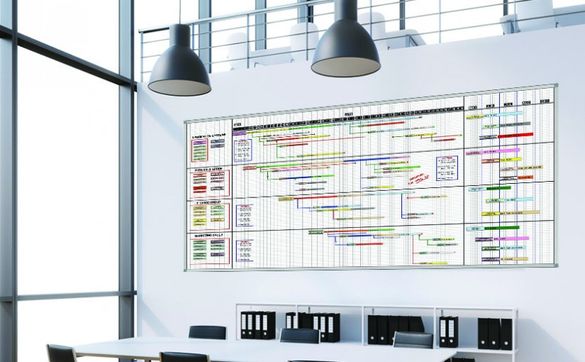Magnatag InSight
The whiteboard and how it helps us brainstorm, innovate, motivate and create
RECENT BLOG POSTS
- How to Eliminate Scheduling Chaos with the Right Business Calendar
- The Educators’ Choice: 8 Leading Whiteboards for Group Learning
- Glass vs Porcelain vs Melamine: Which Magnetic Dry Erase Surface Lasts Longest?
- Full‑Wall Whiteboard Panels vs Paint: Performance, Cost, and Longevity Compared
- The Definitive Guide to Creating High‑Quality Branded Whiteboards with Magnatag
- Glass vs. Porcelain: Which Whiteboard Surface Fits Modern Offices Best?
CATEGORIES

3 Ways You Can Use Gantt Charts To Enhance Project Management Output
Mon Jul 18 2016By: Mike P
Whether you work in sales, manufacturing, education, or healthcare, it's likely that you've become familiar with Gantt charts. Designed in the early 1900s by Henry Gantt, Gantt charts have revolutionized the way we organize information in the workplace. At Magnatag, we know just how integral Gantt charts are to a successful operation, so we’ve created a list of ways you can use them to your advantage when dealing with project management.
- Gantt Charts Improve Employee Motivation Setting goals is widely considered to be one of the best practices for maintaining a successful career, as goal setting gives you something to strive towards. You may notice that many companies will implement goals to streamline focus groups or individual team members. So it should come as no surprise that Gantt charts are commonly found at the center of the goal setting process. By creating a large-scale company planner or calendar within the workplace, you can give your employees a chance to look at the company's big picture. Employees will be able to identify how their job impacts the rest of the group, thereby making them more conscientious of their importance to workflow progression. As a result, you’ll likely notice that employees will begin to take more initiative when it comes to projects or other deadline-driven assignments.
- Gantt Charts Increase Employee Preparedness
As employees begin to take on a stronger sense of accountability, Gantt charts become an increasingly popular tool to help create a more prepared ecosystem amongst your staff. Gantt charts offer you an easily accessible timeline that can help team leaders allocate tasks in a more efficient manner. By simply glancing at a chart, a team leader can effortlessly determine which dependencies they are falling behind on and allocate their resources accordingly. If a team leader notices an excess amount of work is going into a specific deliverable while others are falling behind, taking action to prevent these measures can help your team avoid any hiccups that may occur later in production. Being able to take action in accordance with time and production constraints is a key indicator that you have found yourself an exceptional project manager. - Gantt Charts Encourage Collaboration
Gantt charts are most widely recognized as an easy to use tool for visually displaying information. Be it project components or timelines, everything displayed on the board becomes a piece of visual focus for the room. Many offices treat Gantt charts as an invite for collaboration. Team members can openly interact with the board communicating schedule changes and other important points of interest, and given that multiple changes can be made to the board on a daily basis, you’ll notice an increase in communication internally. You’ll see team members convening around the chart in an effort to coordinate plans and projects, which can ultimately lead to a better-rounded product. With Gantt charts becoming a more conventionalized form of planning and tracking, they’ll also serve the ultimate function of facilitating communication in your office.
Categories:Productivity